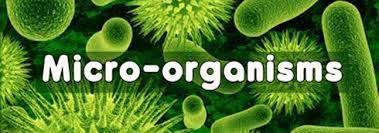Microorganisms Series part #1
Meaning of Microorganisms
Microorganisms are tiny organisms which cannot be seen with the naked eye except with the use aid of microscopes. The branch of biology which involves the study of organisms that are microscopic in sizes is called microbiology.
.jpg)
Microorganisms are found everywhere - in the soil, air, water, on our clothes, bodies, inside our bodies etc. Some of the microorganisms are beneficial, harmless of non-pathogenic while others cause diseases and are referred to as pathogenic and therefore harmful.
Groups of Microorganisms
All microorganisms are grouped into following:
(1). Viruses
(2). Bacteria
(3). Protozoa
(4). Fungi
(5). Algae
Viruses
Viruses are microorganisms that are too tiny to be seen with an ordinary microscopes except with the use of electron microscopes. Viruses are the simplest and the smallest microorganisms which do not have cell structure. Some are rod -like on shape while others are spherical. Each cell consists of a strand of nuclear protein. Virus may be grouped into DNA and RNA viruses. Some may be enveloped or without an envelope, that is, they are naked and can only reproduce inside a living cell. Examples of viruses are Adenovirus, Picornavirus, Togavirus and Coronavirus.
.jpg)
Bacteria
Bacteria are microorganisms that can easily be seem with light microscope. They occur in clusters colonies. A bacterium has a slimu capsule, cell wall, a cell membrane, a dense cytoplasmic granules with no clear nucleus but has a nucleus material called DNA(Deoxyribose Nucleic Acid) which spreads through the cell.
.jpg)
Types of Bacteria
Bacteria are grouped into two major types These are:
(a). Bacteria on the basis of the use of oxygen: Under this group, there exist three types. They are:
(i) Aerobic bacteria: These are bacteria that require oxygen for their respiration.
.jpg)
(ii) Anaerobic bacteria: These are bacteria which do not require oxygen for their respiration.
.jpg)
(iii) Falcultative bacteria: These are bacteria that can live under aerobic and anaerobic conditions.
.jpg)
(b). Bacteria on the basis of their shape: Under this group, there exist different shapes of bacteria. These are:
(i). Cocci: Cocci are circular in shape. Some may stick together to form a chain, hence they are called Streptococci, e.g sore throat bacteria. Others which occur as bunch or in cluster form are called Staphylococci, example boil bacteria. Yet some other bacteria called Diplococci stick together in pairs, an example Is the bacteria that causes pneumonia. Again, when bacteria occur in group of four, they are known as tetrads
.jpg)
(ii) Bacilli: These bacteria are rod -like in shape. Some have flagella which they use for movement, example is the bacteria that cause typhoid fever.
.jpg)
(iii). Vibro: vibro are curved in shape, just like a comma, an example is the cholera bacteria.
.jpg)
(iv). Spirillae: Spirillae are spiral and twisted bacteria. Some are mobile, an example syphilis bacteria.
.jpg)
Protozoa
Thesre microorganisms are microscope, free-living, unicellular animals. Examples are Amoeba and Paramecium. Some are parasites, examples are trypanosomes which causes malaria fever.
.jpg)
Fungi
Fungi are saprophytic of parasitic non - green plants. The saprophytic fungi are beneficial while parasitic fungi cause different types of diseases.
.jpg)
Algae
Algae are microscope green plants with the majority mainly found in aquatic environment, examples are Diatoms, Spirogyra, Volvox, Chalamydomonas, Oscillatoria and Nostoc.
.jpg)
.jpg) .
.
@originalworks